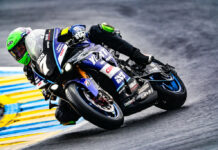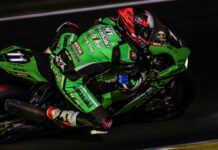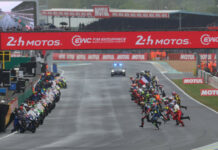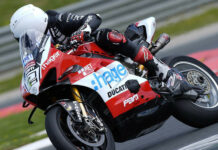TESTING, TESTING, TESTING How winter testing lays the foundations of Michelin’s MotoGP success MotoGP is all about racing and winning but success during the summer racing season can usually be attributed to behind-the-scenes work during winter testing. Indeed riders cover many more laps during winter tests than they do actually racing. Nicolas Goubert, Michelin’s director of motorcycle racing, explains how the French company goes about its winter testing program in order to be best prepared for the next MotoGP World Championship. The some of Michelin’s best MotoGP riders take their turnÅ Q: How does the Michelin winter testing program work? A: We try to concentrate first on tire profile and size, because these are the most difficult factors to change and because they need to be confirmed as soon as possible so the teams can tune bike set-up. The first thing we do is give the basic dimensions of a new tire to the teams so they can set up their bikes  ride height, gearbox and so on. Then we start work on tire construction and finally we look at compounds. So the main focus points during the inter-season are profile, size and construction because when you work on compounds you are only really working for each individual racetrack, so we continue working on compounds even as we go from track to track during the season. When we do work on compounds during the inter-season it is more likely to be more experimental, trying something very different. Q: How do you decide on tire profile and size? A: From the feedback we get from our MotoGP riders and teams during the previous season and from our own simulations and bench testing. We start off with computer simulations. Say, for example, we wanted to increase the size of the tire contact patch at medium lean angle as the rider is leaning into corner. We create a virtual tire and look at the contact patch that profile would give us at 25 to 40 degrees lean angle, as well as what force that profile would create. Once you’re happy with the results achieved by the computer simulation you build a tire and test it on a tire dyno to make sure you get the same kind of results you were aiming for in the simulation. If the tire works well on the dyno you then try it on a motorcycle on a racetrack. We usually start this program in the late summer, so we have already had a lot of races at a lot of different racetracks, which means we’ve got a good idea of what we want for the next season. Q: What about this winter, with the new 800s on the way? A: This winter will be a bit different because everyone is using new bikes for 2007. Our MotoGP partners Honda and Yamaha have given us an indication of where they want to go with the 800s, what kind of character they expect from their bikes, plus an indication of horsepower outputs. We take all that into account plus riders’ comments from the season. Then we decide on a direction, so we are ready as soon as possible to test in November. We are looking forward to the first serious 800 tests once this season is over, then we can look really carefully at what kind of profiles will be best suited to the bikes. Q: How many different tires do you test during a typical winter? A: We don’t actually test many different profiles because making a tire takes a lot of time and money, that’s why we do so much work on computer simulations. Last winter we tested two different rear profiles. And we quickly decided which of those two we would race with, following comments from different riders with different bikes. Q: Once you’ve started testing, how long does it take to produce a new profile? A: It could take maybe a month to produce a new profile, so you could do that during the winter, though if you wanted something drastically different it might take much longer. We have some programs that go on for ages, maybe a few years. Q: And how long to produce a new construction? A: Again, it depends on how much you want to change things. If you were making just a small adjustment to a construction you could do it in a few days, while a major change could take one or two years. Q: What is the process once you start testing? A: You always work by comparison. You bring the previous season’s profile to the early winter tests, in a compound that has worked well during the GP at that track, then you make comparisons with different riders. Even the first four or five laps with each rider can give you a good first impression of what the tire is like. If the riders are happy with the tire and there’s no problem with tire temperature or wear, we quickly move on to race-distance testing, because endurance is always the key, that’s where the results come from. It may be easy to find half a second a lap with a new profile, but that’s of no use to us if tire performance drops off after a few laps. If the endurance results are good, we move on to try the same tire at other racetracks before we can really decide if we are moving in the correct direction. Just because a tire works well at one track, doesn’t mean it will immediately work well at others. And if it works really well at one track but doesn’t work at the next two or three, then we have to put it aside. Q: How do you work with your riders? A: We ask them to be as precise as possible in the comments they give to us, but essentially the way we work with our riders during testing is the same as the way we work with them at races. Q: What does it take to be a good test rider? A: First of all the rider must be very fast! If we are to get really good feedback and information from a rider he also needs to be happy and confident on the bike and he mustn’t be distracted by any kind of problem. In addition to all of those factors the rider needs to have a very good feel for what’s happening out on the racetrack and he needs to be able to explain what’s happening, because feeling is one thing, explaining in language that can be understood is another. To mention a few, Valentino (Rossi, Camel Yamaha Team YZR-M1-Michelin) and Colin (Edwards, Camel Yamaha Team YZR-M1-Michelin) are very gifted at this, also Dani (Pedrosa, Repsol Honda Team RC211V-Michelin), and Kenny (Roberts Junior, Team Roberts KR211V-Michelin) is also very precise and experienced. THE RIDERS’ VIEWPOINT Kenny Roberts Jr. and Colin Edwards are two of Michelin’s best MotoGP test riders and crucial contributors to Michelin’s R&D program. So what do they think is the secret to being a good tire tester? Kenny Roberts Jr. Q: Why are you good at testing? A: I’ve always needed a lot of grip and a lot of turning from my tires, and to get that you end up spending a lot of time getting to know the tires. I don’t know, it’s just something I’m good at, I give good feedback. You just try and tell the Michelin guys what the tire feels like, turning-wise, grip-wise, under braking and so on. It’s basically all about understanding how a tire works. Q: How important is winter testing? A: There are a lot of things we go through during the winter, a lot of stuff that we need to get ready for the new year, but I’d say that tires are the biggest thing. Tires and the progress of your suspension set-up are probably 60 to 70 percent of your testing load. Q: Why do Michelin have the edge in MotoGP? A: From what I can see the company seems to be very motivated and very focused on what their achievements need to be. They want to win the championship, they want to win every race and they want to win qualifying. For them it’s not just an engineering exercise, it’s also a competition. Plus they’ve got a tremendous amount of experience. Q: How many tires do you test at each winter test session? A: Anything from ten to 30. You’ll do between five and seven laps on each tire to get an idea of what it’s like, then you may go try a race-distance run. Q: Is it more difficult to push a front to the limit and thus to test it fully? A: In some ways it’s easier to get the initial feeling of a front tire. But you can only really base what you think about a front on the feeling and the turning it’s giving you, rather than from sliding it into the corners. You don’t slide much with the front, not on purpose anyway! Colin Edwards Q: What does it take to be a good test rider? A: First off, a good rider has to know what he wants. I think that’s the important thing because you can get lost. I’m a racer, not an engineer or some suspension guru, so I just translate stuff the best I can to my guys. A lot of testing is just elimination, you’re eliminating certain ideas that the team has to get the bike to handle better, to stop better or whatever. Q: How difficult is it to push a new tire to the limit? A: For me it’s easiest to test tires, because the tires are the things touching the ground and you can usually tell within a lap or two if a tire is better or worse. With some other stuff it’s difficult to feel any difference. But, of course, testing tires isn’t at all easy. You’re riding 98 or 99 percent, at 100 percent some laps, because that’s the only way to get accurate information. You can’t go out there and run at 90 percent. Q: You seem to enjoy testing more than some riders, why? A: A lot of people despise having to ride lap after lap but when I was doing World Superbike I really started buckling down and going to Ladoux (Michelin’s Clermont-Ferrand test track) three times a year and burning a couple of thousand laps, I started to see how much we progressed their tires. To me it feels like we do more testing than racing, but once you see the results it’s all worth it. You go to a few different tracks and if something works, you keep it, but often it’s not better than your base line, so you eliminate it. A lot of time it feels like you’re doing lap after lap after lap for nothing but you’re always building data. Ninety percent of testing involves tires, some of it long-distance stuff when Michelin wants to know if a good tire will go the distance.
Michelin Plans Extensive Winter Testing Program For MotoGP Tires
Michelin Plans Extensive Winter Testing Program For MotoGP Tires
© 2006, Roadracing World Publishing, Inc.






